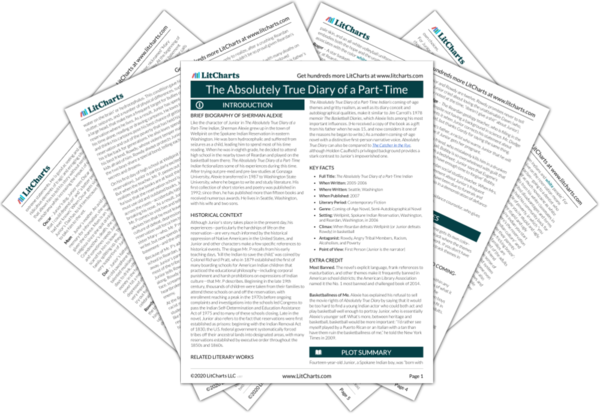Identity, Belonging, and Coming-of-Age
Junior is hyper-conscious of his place within any social group. In addition to his awareness of what it means to be white versus what it means to be Indian, he worries about how to be a man (when men can cry, when boys have to stop holding hands with their friends) and how to fit in as a “freak” who is bullied by his peers and even by some adults. Beginning his story “I was…
read analysis of Identity, Belonging, and Coming-of-AgeOverlapping Opposites
Junior often sees himself and his world in terms of strict dichotomies: white versus Indian, friends versus enemies, rich versus poor. In his double life in Reardan and on the reservation, he feels “like a magician slicing himself in half, with Junior living on the north side of the river and Arnold living on the south.” Yet just as his true identity includes both Junior and Arnold, the divided extremes he describes often turn out…
read analysis of Overlapping OppositesRacism, Poverty, and Alcoholism
“I’m fourteen years old and I’ve been to forty-two funerals,” says Junior after losing three loved ones in alcohol-related accidents. “That’s really the biggest difference between Indians and white people.” For Junior, to be Indian and to live on the reservation means dealing not only with overt racism—going to a dentist who believes Indians only need half as much novocaine as white people do, or facing racist insults from his white classmates in Reardan—but also…
read analysis of Racism, Poverty, and Alcoholism
Confessions, Revenge, and Forgiveness
Confessions, revenge, and forgiveness are central to the plot of The Absolutely True Diary of a Part-Time Indian. Junior decides to transfer to the school in Reardan because of a conversation with Mr. P., a white teacher whose nose he has broken by throwing a textbook across the room. Mr. P. forgives Junior for breaking his nose, but asks for forgiveness in return: he has been part of a system that forced Indians to…
read analysis of Confessions, Revenge, and ForgivenessHope, Dreams, and Loss
It may seem contradictory to include hope, dreams, and loss in the same category, but in fact, in Junior’s experience, they’re very closely connected. At the beginning of the novel, Junior understands dreams and hopes primarily as lost opportunities: his mother and father, for example, “dreamed about being something other than poor, but they never got the chance to be anything because nobody paid attention to their dreams.” The same thing is true for his…
read analysis of Hope, Dreams, and LossDrawing, Writing, and Junior’s Cartoons
One unique aspect of Absolutely True Diary is the way that images are incorporated into the text. Junior is an aspiring cartoonist who uses his drawings to tell his story, and the cartoons work throughout the novel in several different and important ways. Sometimes they are integrated seamlessly with the written narrative, providing dialogue or visual information that isn’t shown elsewhere; for instance, the moment when Junior throws his geometry book and breaks Mr. P.’s…
read analysis of Drawing, Writing, and Junior’s Cartoons











